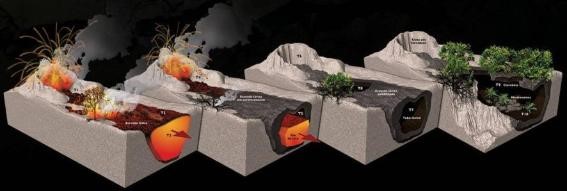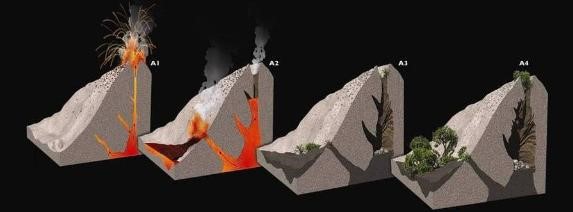Volcanic caves are not a very frequent geologic phenomena though they can be found in several places where magma ascends to the surface, like the Azores, Canary islands, Iceland, Italy, Japan, Kenya and Korea.
The Azores archipelago displays a rich and diversified speleological heritage due to its volcanic nature and the presence of basaltic lava flows.
We can consider two main types of volcanic caves: lava tubes and volcanic pits.
Lava tubes genesis can be simply explained the following way: a lava flow moves down the slope, the cooling of its superficial and lateral zones (in contact with the air and surrounding rock formations) occurs and a crust is formed, nevertheless, underneath it hot lava continues to flow. After that, due to a decrease in the volcano´s emission rate the lava level inside the tube lowers gradually, forming, thus, a cavity under the already solidified superficial crust. When the volcanic eruption ends a lava tube is formed and later some ceiling collapses tend to occur originating skylights. Over time there is also the colonization by plants on the lava fields particularly near the cave entrances.

On the other hand, volcanic pits are mostly ancient vertical volcanic conduits that have been lava drained as a consequence of the arise of a new vent/eruptive center at a lower level or the decrease of lava emissions from depth leading to a lateral and/or in depth drainage of magma and the partial emptiness of the feeding conduits. As the eruption ends there is the cooling and solidification of the conduits and there might be some collapses from the walls, increasing pit´s dimensions and creating gravity deposits at the bottom of the pit.

Nowadays, there are 271 volcanic caves known in the Azores spread all over the archipelago with the exception of Corvo island.

Pico island presents the largest number of caves (129) making about 48% of the total, followed by Terceira island with 26% of the archipelago caves.
In São Miguel we currently know 28 volcanic caves, most of them located in “Complexo Vulcânico dos Picos” a recent region of basaltic fissure volcanism that develops between Sete Cidades volcano and Fogo volcano, covering the parishes from Capelas to Ribeira Grande (North shore) and from Ponta Delgada to Lagoa (South shore).
Gruta do Carvão cave system is the largest known in São Miguel island and one of the most remarkable of the entire archipelago with about 2,5 km of total length since coastline of Ponta Delagada up to Arrifes parish.
Due to its location, size, variety of geological structures and volcanic phenomena associated with, Gruta do Carvão was classified as Regional Natural Monument by the Regional Decree Nº4/2005/A of May 11th.



